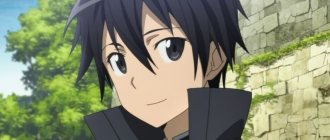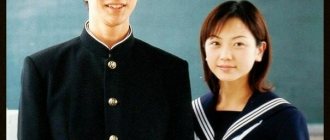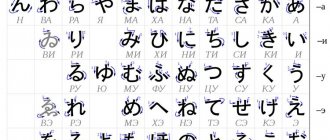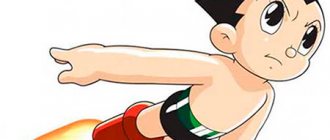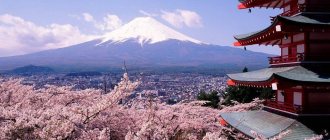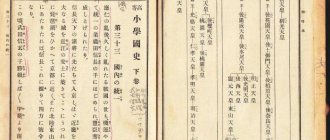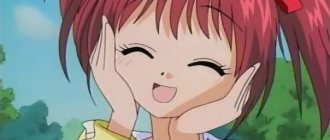Animated films have been created for over a century all over the world. During this time, some countries have become real leaders and literally legislators in this branch of the entertainment industry, while others modestly and quietly create their own films and show the products of foreign manufacturers. But there is a special case in this brightly drawn universe - anime. This word, in general, means “animated film,” but throughout the world it refers exclusively to Japanese works of this genre. Why did cartoons from the Land of the Rising Sun conquer the world? Let's find out!
Brief information
Anime is essentially a Japanese derivative of animated films created in the West and the United States. The beginning of the history of this genre is associated with the first experiments of directors of the Land of the Rising Sun at the beginning of the last century. By borrowing some technologies from the pioneers and adding a little of their own traditions and features, manga authors created real masterpieces that were able to conquer the whole world in less than half a century.
How and when did Anime appear?
We owe the emergence of a huge anime culture to comics, namely manga . They first heard about it in 1914 from the artist Hokusai Katsushika, who gave this name to the strange, funny pictures. In Japan, absolutely everyone reads manga. Comics gained wild popularity thanks to the efforts of the Japanese government, which saw them as leverage on society. Interesting to know.
Manga is almost always drawn in black and white; comics are very rarely in color.
Anime is not only an adaptation of manga, but also video games, and light novels, and sometimes even classical literature is used as a primary source. In addition, a cartoon may not be related to anything and may be an independent work.
Anime culture emerged in the early 20th century, presumably due to Americanization. The Japanese took some of the techniques of American animation and added different graphics and style.
The very first animation in the new genre is considered to be “New Sketchbook” from director Shimokawa Dekoten, which, unfortunately, has not survived.
Tezuka Osamu, the greatest mangaka in history, became one of the pioneers in the then new field of entertainment. It was he who suggested making not full-length films, but making series that the Japanese liked. This is how anime turned into pop culture. Interesting to know.
An artist who draws Japanese comics is called a mangaka.
For boys and girls, as well as their parents
Anime is drawn films for any age category. In this vibrant variety, children (such films are usually called kodomo) and teenagers will find interesting stories. Moreover, for young people, anime is divided into several categories: shonen for boys and shoujo for girls. They differ significantly. Kodomo tell simple, uncomplicated stories about the adventures of small and funny characters. Teenage girl anime are about love and hate, tenderness and rudeness, beauty and fashion, mysticism and magic, in general, about what is interesting to young representatives of the fair sex. Shonen tell about the lives and exploits of various superheroes, warriors and real macho men. Anime for guys also contains relationships and mysticism, but still, stories about battles and fights between good and bad characters, both people and representatives of other civilizations or simply fictional characters, predominate.
Lately, “adult” anime has become increasingly popular. These are drawn stories that are often in no way inferior in plot to full-length feature films or TV series. They reveal serious questions and themes, they make you think. There are also paintings that are not for everybody – about same-sex relationships or with elements of “strawberry”.
The best anime are successfully shown in cinemas all over the world and are not inferior to works of other genres in terms of box office receipts. For example, “Spirited Away” directed by Hayao Miyazaki, among other awards, received the Berlin Film Festival award in 2002 as “Best Film” and the Oscar in 2003 as “Best Animated Film”, and its box office receipts exceeded $250 million .
What is "anime"?
In Japan itself, the abbreviated term “anime” (アニメ) refers to all animated films (アニメーション) , regardless of the country of origin. Outside Japan, this term refers only to animated films made in Japan, already emphasizing their originality.
What is the difference between anime and animated films from other countries?
The differences are few, but they are significant. Anime is animation designed for a wide audience, not just children. Anyone of any age can find colorful films to suit their taste and needs. Anime has a characteristic expressive depiction of characters and their environment, a characteristic way of conveying movement. Often, anime have a main theme or main song that famous pop and rock artists compete to perform: being in the film means gaining popularity. Lastly, anime are based on manga, a never-ending source of inspiration for Japanese anime artists. Just like manga, anime can continue in endlessly long episodes, which draws in the reader and viewer, eagerly awaiting new releases. Anime facilitates communication between fans of a particular genre who want to express their opinions.
Bright appearance
Among other things, anime is also a complex system of graphically representing people, their characters and emotions. It has its own characteristics and strict rules. Firstly, the appearance of the characters is always pronounced - the European shape of the huge eyes, borrowed from Disney animation. And this is not without reason! With the help of big eyes, anime artists convey the emotions and character of the hero. It is noteworthy that the facial expressions of the characters are the same in all films, which allows the viewer to easily determine what the hero is thinking and feeling, whether he is positive or negative, when watching any film of this genre. The remaining facial features, as a rule, are poorly drawn and do not carry any meaning.
When asked what anime is, many will answer that these are cartoons in which the characters have big eyes and colored hair. And it will be true! The second distinctive feature of these works is the outlandish hairstyles of the characters. They usually consist of strands, but the variety of their lengths and colors is simply amazing. And this also has its own meaning. Hairstyle and clothing allow you to determine the character and characteristics of the character literally at first glance. This is caused primarily by the fact that the vast majority of the Japanese themselves have dark hair from birth, and dyeing or lightening it is perceived by the conservative nation as a protest and a challenge to society.
Variety of formats
So what is anime - a film or a cartoon? In fact, there is no clear answer to this question. The thing is that anime is filmed in different formats.
- The television series is the most widespread. Multi-part stories about the lives and adventures of heroes last from several episodes to several hundred and are broadcast on television.
- A film is a full-length film intended for screening, primarily in cinemas.
- OVAs are works created specifically for sale on media and, as a rule, are not broadcast anywhere.
- ONA is an anime filmed for distribution on the Internet. This is the newest format, which has not yet gained much popularity, but there are high hopes for it.
Anime phenomenon
Japan, with its island geographical position and its policy of isolation for several centuries, is destined to be a special country, which is manifested in particular in literature and art. Japanese animated films, often based on manga, reflect the unique traditions and customs of the people, which cannot but arouse the interest of any viewer. Anime can be called an international language that, with the help of visual means, makes Japan closer and more understandable to everyone.
Many anime are films with a full-fledged plot line, which touches on issues that concern many: the consequences of the Second World War, relationships between different generations, life difficulties, romantic relationships, environmental problems, morality and ethics. The fantastic world of anime poses questions that humanity will have to solve in the near future.
In addition, the Japanese are very skillful at promoting their products through advertising: images of anime characters or names can be found in the media and on various products. This is greatly facilitated by the “cosplay” movement (a derivative word from “costume play” - costume game), when fans of one or another anime dress up in the clothes of their favorite character, try to resemble him in appearance, but most importantly, try to match him in the soul.
The world of anime is so diverse that it is difficult to fit it under one definition. It’s better to look and form your own opinion. Moreover, you will enjoy it a lot.
The plot is fascinating
The plots of films and TV series of this genre are very diverse. Everyone can choose something to their liking. There are anime about love, friendship and betrayal, unusual phenomena, about aliens and future technologies, about battles and exploits of warriors or entire armies. In general, historical, romantic, dramatic, thrillers, mysticism, fantasy - everything, as in the familiar world of full-length feature films and television series.
How anime is divided into genres
Anime genres are divided according to two criteria: the age of the audience and the plot.
In the first case it is:
- For children under 12 years old (kodomo means child in Japanese).
Entertaining series are not much different from their foreign counterparts. Examples that everyone has encountered: “Sonic” or “Pokemon”.
- For boys from 12 to 18 years old (shonen).
This is the most common type of anime. The plot is usually centered on adventures and dynamic developments. All this is seasoned with humor and irony. Examples: "Naruto"
- For teenage girls (shoujo).
This genre is characterized by the presence of a love story, girlish experiences and handsome male characters (where would TV series for girls be without them!). Examples: “Friendship Notebook.”
- For men (seinen).
Dark and incredibly realistic paintings with elements of eroticism. They are filled with philosophical discussions about the meaning of life, alcohol flows like a river there.
- For women (josei).
The same shojo, only for older people. It tells about the everyday life of women: about divorce, problems in the family and other horrors of adult life.
southern division differs from the age division :
- Cyberpunk - depicts the future in all its dark manifestations.
- Furs – pictures about giant robots.
- Steampunk – talks about parallel universes.
- Science fiction - the main storyline is travel into space and communication with humanoids.
- Fantasy - tells about worlds where high technology is combined with traditional weapons.
- Apocalyptic - shows what the world will be like after the end of the world.
- Hentai is an anime containing many erotic scenes.
Pictures come to life (manga)
What are anime and manga? How are they different and what do they have in common? These two concepts are, in principle, inseparable. Manga are hand-drawn Japanese comics that are usually the basis for anime. In rare cases, the opposite happens - the cartoon script is transferred to paper in the form of pictures. Manga gained particular popularity in Japan after World War II. Drawing books were read by people of all ages, regardless of their social status. Today there are entire publishing houses and chains of stores dedicated exclusively to this area of culture. Many young artists undergo extensive training and dream of making their mark on bookshelves as manga authors.
Japanese culture in anime. Part 1.
Of course, in order to fully perceive anime, you need to know Japanese, and ideally be Japanese. But the vast majority of anime fans know Japanese culture solely from the films they have watched. The fact is that Japanese society is very unique; the language, culture, traditions, principles and morals are unusually far from ours. One can only marvel at the talent of Japanese authors who, through the prism of their perception, were able to create such universal works that have fans all over the world, including in Russia. However, for foreigners a lot of things in anime often remain incomprehensible, or rather, we simply don’t notice some nuances, because we have different psychological accents and a different culture.
“Polivanova System” vs “Romaji”: is it Sushi or Sushi?
The history of transcription of Japanese words into Russian is very fascinating and goes back about 130 years. It all started in 1867, when the American physician and linguist James Hepburn published a Japanese-English dictionary, where words were written not in hieroglyphs or alphabet, but in English letters. His system was based on transcription, i.e. Hepburn selected letter combinations that most adequately convey the sound of Japanese words in English, hence the origins of Sushi and Geisha.
The dictionary was successful because it allowed foreigners to quickly learn phonetics and expand their vocabulary of Japanese words and expressions without deep study of Japanese writing, which 130 years ago was much more complex and confusing than modern writing. Soon, this system was adopted in Japan itself; in particular, already in 1908, the Hoepbren system was adopted in Japan as the official system for transcribing Japanese words in Latin letters.
The Russian Empire had rather weak contacts with Japan at that moment, and most Japanese words came into the Russian language mainly from English and French. Since at that time the Russian language did not have an adequate system for transmitting Japanese words, they were written in Russian letters similar in sound to the English transcription. Soon after the appearance of the Hepburn system, the Japanese physicist Aikitsu Tanakadate created another system of transliteration of Japanese words, which most accurately conveys not the sound, but the spelling. It began to actively displace Hepburn’s “pro-American” transcription and in 1937 it was approved as official under the name “prescribed Latin”. The names of signs and surnames in international passports were rewritten, and by 1942 the victory of the “prescribed Latin alphabet” became complete and final.
In 1930 in Russia, a talented Japanese linguist Evgeny Dmitrievich Polivanov developed a system of transcription of Japanese words into Russian, based on the “prescribed Latin alphabet” with the difference of only some sounds: the sounds “fu” and “tsu”. At that moment, for linguists around the world, the victory of the “prescribed Latin alphabet” was beyond doubt. But the cards were confused by the Second World War, in which Japan suffered a crushing defeat, and the second order of the US occupation government was the revival of the Hepburn system with minor modifications called Romaji, signs and foreign passports were again rewritten, this time irrevocably.
On the other hand, the Polivanov system has managed to officially establish itself in Russia. There was no one to make adjustments. Polivanov himself, like many other linguists, was executed on suspicion of espionage in 1938, and the sphere of interests of the USSR at that moment did not include the linguistics of the Japanese language. Therefore, on the one hand, the Russian word Sushi does not convey the sound of the Japanese Sushi, but it is correct to write “si” and not “shi”, despite the fact that some Japanese names and names take on a slightly ridiculous sound, compare “Nishihiro Nishi” and “ Nishihiro Nishi." Of course, it would be best to create a new system that uses all the richness of the sounds of the Russian language, but the rooting of Polivanov’s system seems to be irreversible.
Now let's get back to the translations of anime into Russian. Most often, amateurs do this and they translate, as a rule, from English and do not know the history of the issue, and they translate names and titles, simply conveying the sounds of the Romaji system in Russian letters as 130 years ago. Therefore, among anime fans, the Russified Hepburn system is most common. Moreover, even knowing about Polivanov’s system, many anime translators refuse it due to phonetic distortions, but this is contrary to the rules of the Russian language.
The main differences between religions are food and sex.
There is no official religion in Russia, because... Church is separated from state. The most widespread is Orthodoxy, and this is one of the significant mechanisms for shaping the mentality of society. Personally, you may be an ardent atheist, but please note: food and sex still do not come first in the system of cultural values of the Russian person. Why? It's simple: in Christianity, sex and gluttony are sinful, these aspects of human life are perceived as vulgar, they are not talked about. It is the spiritual life of a person that is put in first place, and not necessarily the religious one. A conversation between two Russian people is more likely to be about a new book or movie than about a good restaurant. This is not good or bad, it is a mentality. In Japan, where Buddhism and Shintoism are widespread, everything is different: food is perceived as an important and exclusively positive part of life. Broader views on sex are reflected in much more tolerant censorship and a relaxed attitude towards homosexuals. Compare with our attitude, with this combination of contempt and morbid curiosity. For the same reason, anime characters are erotic, and their actions are sexually charged, while Russian or American cartoon characters are practically sexless.
Beauty in Japanese
Have you ever wondered why, of all the Russian pop performers, only Tatu so quickly and unconditionally won the hearts of Japanese youth? It's not just about the pink hue of the performers, as some people think. It’s just that female beauty in Japan is perceived somewhat differently than here. There is a Japanese word for Kawaii. The closest Russian meaning is "darling". It is “kawaii” girls that are the most sexually attractive to the Japanese. But Kawaii is not only a beautiful appearance, Kawaii is also weak, helpless, dependent. The ideal of Japanese beauty is a beautiful but weak, helpless and stupid girl, completely dependent on a man. That is why the most attractive to Japanese men are teenage girls 15-17 years old, because in this case an adult man will inevitably dominate the girl psychologically and sexually. As an extreme manifestation of the desire to dominate a woman - the Japanese art of bondage Shibari, when even the ability to move or breathe depends on the man. Again, for this reason, the topic of rape is quite popular in Japan. These erotic fantasies are actively supported by hentai anime and manga products. However, there is a huge gap from fantasy to real violence. In fact, most Japanese men are quite shy and, by Russian standards, infantile; it is quite normal to begin sexual activity at the age of 23-25 or later.
Sexual relations
The masculinity of Japanese men is primarily determined by height - if it is above average, then the man is already very attractive. In Japan, the average height for men is 160-165 cm, for women 150-155 cm, and sports success is also very important. Unlike Russia, where men show signs of attention to girls, in Japan the opposite is true. It is girls who try to attract the attention of boys; the easiest way for schoolgirls is to offer ready-made lunch in an “obento” box. Unattractive men find themselves in a very difficult situation, girls don’t pay attention to them, and it’s very awkward to get close to someone yourself. Although, of course, quite often boys, having overcome their fear, take the first step. Most often, this is a non-binding invitation to a movie or a recreation park.
If the relationship goes a little further, then the couple walks each other home after school. An interesting form of relationship that we do not have is the exchange of diaries; the Japanese are very sensitive to keeping diaries. However, the diary that is submitted for exchange is often written specifically for this purpose, while the exchange of real diaries is a sign of very great trust. The further development of the relationship is already more similar to what we are used to, gifts, joint trips to the cinema and on a picnic, relationships usually tend not to be advertised.
| Despite the fact that the plot of a guy and a girl living together is often exploited in anime, the Japanese live in a civil marriage relatively rarely; it is considered indecent. The sexual relationships of Japanese teenagers are also quite interesting; as a rule, they live with their parents, but having sex at home is indecent - few Japanese families would approve of a couple just secluded in a room; the thin walls of Japanese houses do not contribute to this either. Therefore, in order to indulge in lovemaking, couples rent a room in a hotel; as a rule, most Japanese hotels allow you to rent rooms for a few hours. Very often a stay at a hotel is preceded by a trip to an amusement park. Particularly popular among teenagers is Tokyo Disneyland, with its chain of hourly Rabu Hoteru (Love Hotel) nearby. A variation of hotel sex is a trip together for a few days to an Onsen (hot spring), usually on a weekend or holiday. If a guy asks a girl to go on vacation together to an Onsen, this actually means a direct offer to sleep. Japanese Social Ladder (Body Rangeji) A specific feature of social relationships in Japanese groups is the vertical of power. Schematically, the positions can be represented as follows: Shachyo - General Director. Buchyo - deputy. directors for certain issues (maybe several) Kachyo - Division Director Kakarichyo - deputy. division director Tantocho (Tantochyo) - responsible Shain - employee. Of course, at the very bottom are foreign employees. Of course, this is a simplified diagram; Depending on the size of the company, there may be fewer positions or, on the contrary, there may be intermediate ones. In general, something similar is observed in Russian companies. But the main feature of the Japanese Body Rangeji is that a subordinate employee can only contact his immediate superior, i.e. a simple employee (Shain) cannot contact Kakarich directly on any issue. He must make the request in writing and submit it to Tantocho, who in turn will transmit it to Kakarich. In the same way, the opposite response will come along the chain. Accordingly, if an ordinary employee needs to contact the general director, the request and response will go through the entire chain. Moreover, if the immediate superior or someone in the chain decides that the topic is not worth the attention of higher authorities, then the request will be safely rejected. In addition, it is the immediate superiors who determine the type of activity of their subordinates. This was done with a very simple and specific goal to increase the efficiency of the team, but on the other hand, in the event of a conflict with the immediate superior, the subordinate cannot even complain to someone superior. A similar problem is very revealing, although slightly grotesquely depicted in the novel and film of the same name “Fear and Trembling.” In anime, this system is rarely shown directly, but if you look closely, when a newcomer joins a team, regardless of his personal qualities, he is treated quite dismissively and assigned all the menial work. Unlike Russian teams, where a newcomer who obediently carries out all the instructions of the “seniors” will be perceived negatively, among the Japanese, on the contrary, it is through hard work that a person can win respect and trust and rise to a new step in the social ladder. There is another feature from the opposite, in many Shonen anime with a teenage hero, the powers that be are forced to be considered because he has some unique abilities or knowledge. |
Watch, don't review
It is believed that the best anime was created by Osamu Tezuka and Hayao Miyazaki. These people laid the foundations and became legends and gods for fans of the genre. However, today the list of anime and their famous authors is simply huge. There are works that are popular all over the world, and there are also those that are known among certain layers of connoisseurs. Here is just a small list of anime that are worth watching:
“Grave of the Fireflies” (dir. Isao Takahata); “Whisper of the Heart” (dir. Yoshifumi Kondo), “Elfen Song” (dir. Mamoru Kanbe, Sumio Watanabe, Akira Iwanaga); “The Shaman King” (dir. Mamoru Hosoda); “Princess Mononoke” (dir. Hayao Miyazaki); “Nausicaä of the Valley of the Wind” (dir. Hayao Miyazaki); “The Wind Rises” (dir. Hayao Miyazaki; “Tales from Earthsea” (dir. Goro Miyazaki); “Cowboy Bebop” (dir. Shinichiro Watanabe, Hiroyuki Okiura); “Spirited Away” (dir. Kirk Wise, Hayao Miyazaki); " Arrietty from the Land of Lilliputians" (dir. Hiromase Yonebayashi); "Vagabond Kenshin" (dir. Kazuhiro Furuhashi) and many, many others.
In life, as in the movies...
There are people in the world who not only know everything about anime, but also literally live in this drawn world. Young people in many countries, and especially, of course, in Japan, have created an entire cultural layer based on the plots of their favorite films. Boys and girls put on contact lenses to convey the color of their eyes, cut and dye their hair in the craziest colors, apply complex makeup, sew to order or buy an exact copy of clothes in specialized stores, and some even undergo plastic surgery to look as similar as possible on your heroes. They have fun, make friends and quarrel, fall in love and build relationships, create families and give birth to children. In general, they do everything that ordinary young people around the world do, only in their own unusual style. What is anime for them? These are not just cartoons, this is a whole universe, their life and world. They know absolutely nothing about reality and, in general, do not strive to find out.
